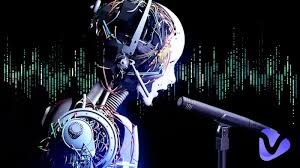
Dubbing studios and voice performers around the world are confronting an unexpected adversary: artificial intelligence. Advances in AI-driven voice cloning and automated lip‑sync tools, once heralded as cost‑cutting innovations, now threaten to upend a $4.3 billion market in 2025 that is projected to expand to $7.6 billion by 2033. In response, voice actors, translators, engineers and their representative bodies have launched a coordinated campaign—uniting under banners like France’s TouchePasMaVF and the global United Voice Artists coalition—to demand legal safeguards, fair compensation and transparent labeling before synthetic voices can replace human artistry.
AI‑Driven Voice Cloning and Cost Pressures
Recent breakthroughs in generative AI have produced synthetic voices that mimic timing, intonation and even subtle emotional inflections of original performers. Startups such as ElevenLabs and DeepDub now offer services that can translate and dub entire scenes in minutes, at a fraction of the cost of traditional studio sessions. One major streaming platform experimented with hybrid models, using AI to recreate lip movements and stitching in human‑recorded lines only when necessary. Meanwhile, tools from Audio Innovation Lab digitally warp an actor’s own recordings into different languages, promising “authenticity and efficiency.”
These technologies have convinced some content owners that they can dramatically accelerate global rollouts while trimming budgets. But the economic calculus overlooks hidden costs: loss of nuanced performance, potential legal battles and damage to a craft honed over decades. In Germany, a pilot AI‑dubbing of a Polish crime series was pulled after viewers complained about robotic delivery and lifeless pacing. Industry analysts warn that if studios opt for fully automated workflows, local dubbing talent—along with dialogue adapters, translators and sound directors—could see hours of work vanish overnight.
Industry Alliances and Legal Battles
Voice actors are not taking these threats lying down. In July, two U.S. performers won the right to pursue claims against an AI‑voice startup in New York federal court, alleging unauthorized use of their voices in training data. Across Europe, the German Voice Actors’ Association (VDS) collected more than 75,000 signatures on a petition urging the European Union to mandate explicit consent and compensation for any AI system trained on artists’ recordings. In France, the TouchePasMaVF initiative has rallied high‑profile talents—such as Boris Rehlinger, the established French voice of Hollywood stars—to lobby parliament for protective legislation.
These alliances have also given rise to a global network—United Voice Artists—representing more than 20,000 performers. The coalition is drafting model contract clauses to ensure that any AI‑generated dubbing bears clear watermarking and that residual payments flow back to original actors. “When intellectual property is no longer safeguarded, creativity dries up,” warns Cedric Cavatore, a veteran video‑game dubber. Legal experts predict a wave of litigation akin to recent lawsuits over AI‑generated music and text, with potential class‑action suits and demands for statutory damages if studios press ahead without agreements.
Regulatory Push and Future of Human Dubbing
Against this backdrop, policymakers face mounting pressure to strike a balance between innovation and cultural integrity. In Brussels, the European AI Act—which will impose the world’s first comprehensive AI regulations—is slated for enforcement by the end of 2025, with an AI Code of Practice to clarify obligations. Voice‑industry advocates are lobbying to classify AI dubbing as a “high‑risk” application, triggering strict transparency requirements, liability for unauthorized use and mandatory human oversight. Meanwhile, in the United States, the Screen Actors Guild‑American Federation of Television and Radio Artists (SAG‑AFTRA) has negotiated contract language that explicitly permits generative AI dubbing only if performers are paid and credited.
Some studios envision a future where AI and human talent coexist. “AI can handle bulk translations and provisional cuts, but only a human voice can convey depth, nuance and cultural context,” says Eberhard Weckerle, director of a Munich dubbing facility. As a result, hybrid workflows are emerging: initial passes with AI prototypes followed by fine‑tuning with professional actors. Nevertheless, union leaders worry that once hacks and shortcuts proliferate, the perceived “good enough” standard will erode quality expectations industry‑wide.
Audience Acceptance and Market Realities
Consumer sentiment toward synthetic dubbing remains mixed. Surveys indicate that roughly half of international viewers would be indifferent to AI‑generated voices, while a quarter would view the content less favorably and a small minority would welcome the technology. Streaming platforms may exploit the ambivalent majority to justify AI deployments, but the vocal backlash from enthusiasts who prize authenticity suggests reputational risks. For distributors and advertisers, negative social‑media campaigns—like the viral TikTok “Protect Artistic, Not Artificial, Intelligence” posts by German dubbers—could tarnish brand image and subscriber loyalty.
Economic projections reflect this tension. While early adopters tout immediate cost savings of up to 60 percent in dubbing budgets, long‑term studies warn of escalating hidden expenses: increased viewer churn due to poor quality, higher legal indemnity costs and the eventual need to re-record poorly rendered AI tracks with human voices. For smaller production houses and regional studios, the lure of cheap AI may prove irresistible, but large players—accustomed to premium localization—risk diluting their own content standards.
As AI capabilities advance toward genuine emotional mimicry, the industry faces a pivotal moment. Voice actors and their allies have shown they can organize across borders, bringing legal, regulatory and public‑relations pressure to bear. The ongoing saga of AI in dubbing is not simply a technical evolution; it is a test of whether human creativity and cultural craftsmanship can assert their value in an era defined by automation. The decisions made by studios, legislators and union leaders in the coming months will shape the future of multilingual entertainment—and determine whether the voice behind the screen remains unmistakably human.
(Source:www.invesitng.com)
AI‑Driven Voice Cloning and Cost Pressures
Recent breakthroughs in generative AI have produced synthetic voices that mimic timing, intonation and even subtle emotional inflections of original performers. Startups such as ElevenLabs and DeepDub now offer services that can translate and dub entire scenes in minutes, at a fraction of the cost of traditional studio sessions. One major streaming platform experimented with hybrid models, using AI to recreate lip movements and stitching in human‑recorded lines only when necessary. Meanwhile, tools from Audio Innovation Lab digitally warp an actor’s own recordings into different languages, promising “authenticity and efficiency.”
These technologies have convinced some content owners that they can dramatically accelerate global rollouts while trimming budgets. But the economic calculus overlooks hidden costs: loss of nuanced performance, potential legal battles and damage to a craft honed over decades. In Germany, a pilot AI‑dubbing of a Polish crime series was pulled after viewers complained about robotic delivery and lifeless pacing. Industry analysts warn that if studios opt for fully automated workflows, local dubbing talent—along with dialogue adapters, translators and sound directors—could see hours of work vanish overnight.
Industry Alliances and Legal Battles
Voice actors are not taking these threats lying down. In July, two U.S. performers won the right to pursue claims against an AI‑voice startup in New York federal court, alleging unauthorized use of their voices in training data. Across Europe, the German Voice Actors’ Association (VDS) collected more than 75,000 signatures on a petition urging the European Union to mandate explicit consent and compensation for any AI system trained on artists’ recordings. In France, the TouchePasMaVF initiative has rallied high‑profile talents—such as Boris Rehlinger, the established French voice of Hollywood stars—to lobby parliament for protective legislation.
These alliances have also given rise to a global network—United Voice Artists—representing more than 20,000 performers. The coalition is drafting model contract clauses to ensure that any AI‑generated dubbing bears clear watermarking and that residual payments flow back to original actors. “When intellectual property is no longer safeguarded, creativity dries up,” warns Cedric Cavatore, a veteran video‑game dubber. Legal experts predict a wave of litigation akin to recent lawsuits over AI‑generated music and text, with potential class‑action suits and demands for statutory damages if studios press ahead without agreements.
Regulatory Push and Future of Human Dubbing
Against this backdrop, policymakers face mounting pressure to strike a balance between innovation and cultural integrity. In Brussels, the European AI Act—which will impose the world’s first comprehensive AI regulations—is slated for enforcement by the end of 2025, with an AI Code of Practice to clarify obligations. Voice‑industry advocates are lobbying to classify AI dubbing as a “high‑risk” application, triggering strict transparency requirements, liability for unauthorized use and mandatory human oversight. Meanwhile, in the United States, the Screen Actors Guild‑American Federation of Television and Radio Artists (SAG‑AFTRA) has negotiated contract language that explicitly permits generative AI dubbing only if performers are paid and credited.
Some studios envision a future where AI and human talent coexist. “AI can handle bulk translations and provisional cuts, but only a human voice can convey depth, nuance and cultural context,” says Eberhard Weckerle, director of a Munich dubbing facility. As a result, hybrid workflows are emerging: initial passes with AI prototypes followed by fine‑tuning with professional actors. Nevertheless, union leaders worry that once hacks and shortcuts proliferate, the perceived “good enough” standard will erode quality expectations industry‑wide.
Audience Acceptance and Market Realities
Consumer sentiment toward synthetic dubbing remains mixed. Surveys indicate that roughly half of international viewers would be indifferent to AI‑generated voices, while a quarter would view the content less favorably and a small minority would welcome the technology. Streaming platforms may exploit the ambivalent majority to justify AI deployments, but the vocal backlash from enthusiasts who prize authenticity suggests reputational risks. For distributors and advertisers, negative social‑media campaigns—like the viral TikTok “Protect Artistic, Not Artificial, Intelligence” posts by German dubbers—could tarnish brand image and subscriber loyalty.
Economic projections reflect this tension. While early adopters tout immediate cost savings of up to 60 percent in dubbing budgets, long‑term studies warn of escalating hidden expenses: increased viewer churn due to poor quality, higher legal indemnity costs and the eventual need to re-record poorly rendered AI tracks with human voices. For smaller production houses and regional studios, the lure of cheap AI may prove irresistible, but large players—accustomed to premium localization—risk diluting their own content standards.
As AI capabilities advance toward genuine emotional mimicry, the industry faces a pivotal moment. Voice actors and their allies have shown they can organize across borders, bringing legal, regulatory and public‑relations pressure to bear. The ongoing saga of AI in dubbing is not simply a technical evolution; it is a test of whether human creativity and cultural craftsmanship can assert their value in an era defined by automation. The decisions made by studios, legislators and union leaders in the coming months will shape the future of multilingual entertainment—and determine whether the voice behind the screen remains unmistakably human.
(Source:www.invesitng.com)





